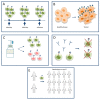A decade of CD4+ chimeric antigen receptor T-cell evolution in two chronic lymphocytic leukemia patients: were chronic lymphocytic leukemia cells present?
- PMID: 37970204
- PMCID: PMC10645517
- DOI: 10.37349/etat.2023.00186
A decade of CD4+ chimeric antigen receptor T-cell evolution in two chronic lymphocytic leukemia patients: were chronic lymphocytic leukemia cells present?
Abstract
On Feb 2, 2022, Nature published the paper titled "Decade-long leukemia remissions with the persistence of CD4+ CAR T-cells" (Nature. 2022;602:503-9. doi: 10.1038/s41586-021-04390-6). According to the results presented, it could be argued that "chimeric antigen receptor (CAR) T-cells can actually cure patients with chronic lymphocytic leukemia (CLL)". CAR T-cells remained detectable more than ten years after infusion, and immunoglobulin heavy chain (IGH) rearrangement deep sequencing showed persistent deep molecular remission for both patients (no CLL clonotypes were detectable six months after CAR T-cell infusion and onwards). However, the existing actual disease status of both patients remained unclear, as it was unknown: (1) if CAR T-cells killed all leukemia cells during the initial anti-leukemic response phase, that is, soon after CAR T-cell infusion into both patients; (2) if few CLL cells survived, but persistent CAR T-cells had been able to destroy any leukemia cells before they reach detectable levels. In the first case, both patients could be considered definitely cured; in the second not and their decade-prolonged deep remission could be a consequence of the cytotoxic activity of the functionally active CD4+ CAR T-cells. The first version appears to be stronger and the supporting arguments have been included in a comprehensive commentary article. A new therapeutic intervention may emerge with the potential to fully improve the quality of life of both patients and in addition, ongoing research into CAR T-cells may turn in a new, more effective direction.
Keywords: CD4+/CD8+ T-lymphocytes; Chimeric antigen receptor T-cells; chronic lymphocytic leukemia; immunotherapy; long-term remission.
© The Author(s) 2023.
Conflict of interest statement
The authors declare that they have no conflicts of interest.
Figures


References
LinkOut - more resources
Full Text Sources
Research Materials
